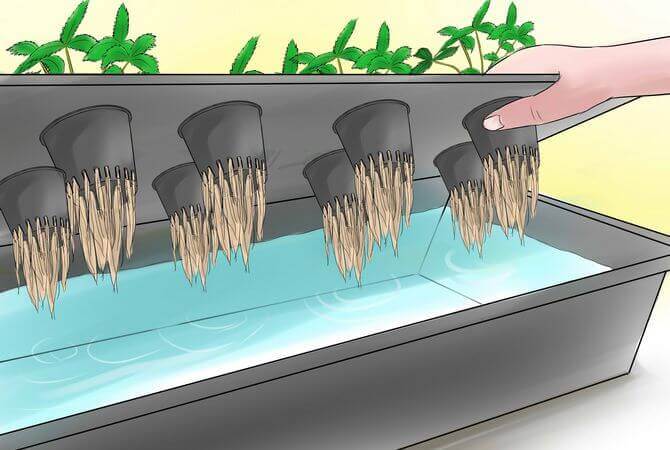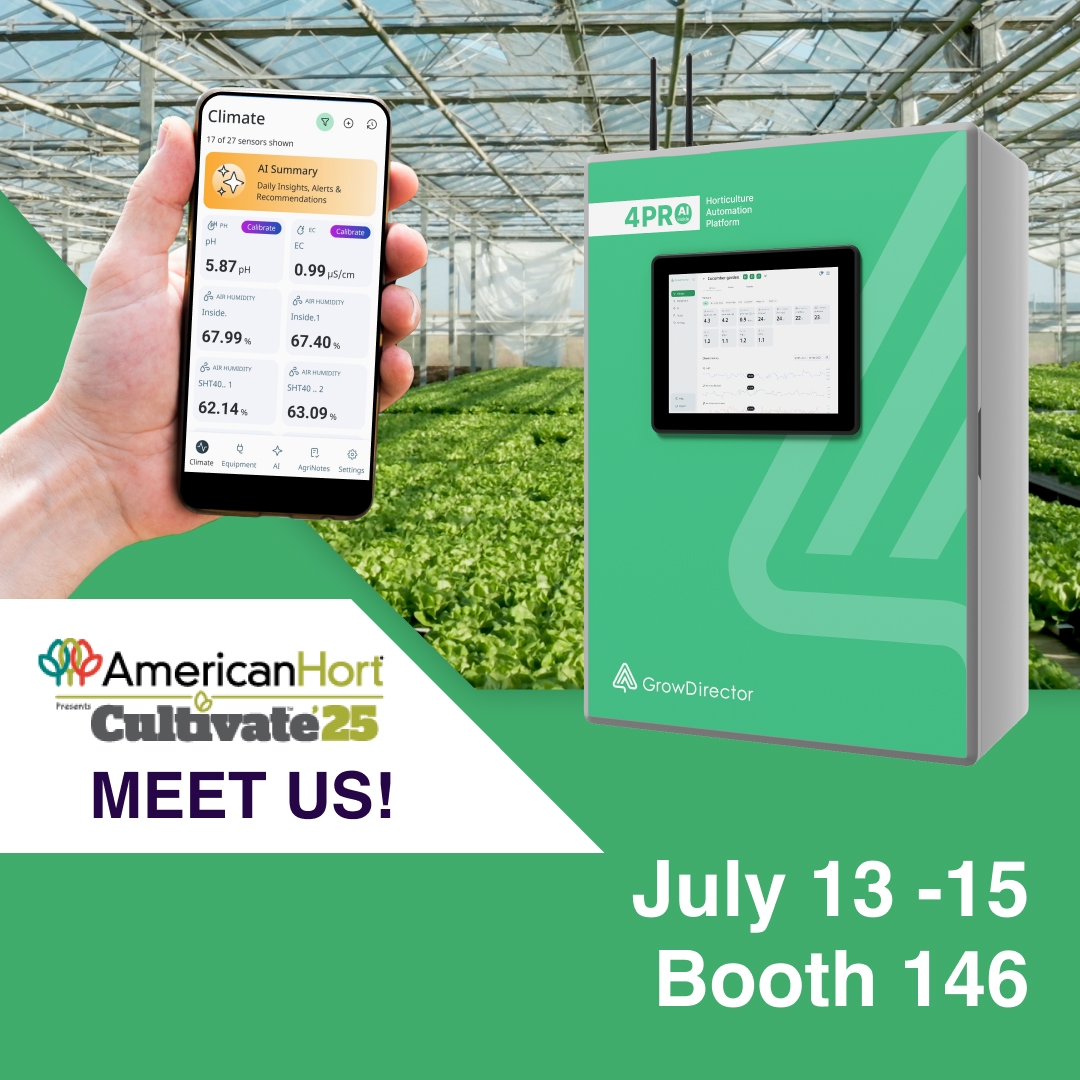
Your guide to passive hydroponic system – what you need to know?
Hydroponic growing systems are a far better option than traditional growing methods. Hydroponic methods ensure the most efficient use of water and increase production. But here’s the thing, they are not cheap.
However, a particular hydroponic system is characterized by lower costs and less maintenance. Passive hydroponics is one of the simplest hydroponic systems that doesn’t require expensive equipment to feed the plants.
In this article, we will discuss all the important aspects of the passive hydroponic growing system.
What is a passive hydroponic system and how does it work

Passive Hydroponic System can be easily automated with GrowDirector 3 pro
A passive hydroponic system is one that uses capillary and wicking action to supply the plants in the system. It doesn’t necessarily require complicated electrical equipment. In this system, the plants are suspended above a reservoir of water.
An electric pump doesn’t circulate the water in the reservoir. Instead, it’s directed to the plant roots through them or through water-permeable media. This is an entirely natural process.
This method is called a passive hydroponic system because we don’t use any active equipment in the system. Instead, we turn all the work over to nature, which does it for us at its own pace.
There are two types of passive hydroponic growing systems – soilless and soil.
How passive hydroponic system works
So, as we’ve mentioned above, there are two types of passive hydroponic systems. They can be constructed differently, but they all work with natural forces. The soilless method uses capillary action, and the soil method uses wicking action.
In the soilless method, the plant is suspended above the water reservoir. A cardboard cutout or a mesh cup can stop the plant. The water level is below the suspension. The plant is forced to search for water.
Some of the plant’s roots reach the water reservoir and supply water to the plant. The sources use capillary action to draw the water from the reservoir. This is basically how the soilless method works.
The soil method works through wicking. The soil used in the passive hydroponic system is clay pellets and pebbles.
A wicking medium connects the water reservoir and the soil. The water flows up through the wicking medium and reaches the ground. It then flows up through the soil medium and reaches the plant roots. The plants then feed on the water and all the nutrients it contains.
The difference between these two systems is that in one (soilless) system, the plant searches for water and nutrients, and in the other (soil), the water and nutrients reach the plant.
The benefits of using a passive hydroponic system
Hydroponic systems are best for boosting growth and increasing plant production. A fully automated hydroponic system for indoor plant growth uses smart control devices to automate the process. You can get similar benefits with passive systems.
- Affordable
The first and obvious benefit of a passive hydroponic system is that it doesn’t require expensive equipment. You can set up a system with empty plastic bottles, pebbles, and a piece of cloth (cotton fabric).
The lack of expensive equipment also means that there are fewer operating costs for the system. This way, you can save more money on nutrients, lighting, and heating. Or better yet, you’ll save money on a smart grow controller.
- Little to no maintenance
A passive hydroponic system is maintenance-free because it doesn’t require expensive machinery and equipment. However, there are some minor maintenance tasks you’ll need to take care of. Filling up the water reservoir (can be automated with a smart grow controller) and wick freezing in the winter (can be solved with automated heaters).
- No need for soil
Another advantage is that no soil is needed. You can completely ignore ground and feed the plants in the system using the soilless passive hydroponic method.

- Power outage is not a problem
There are no electrical devices to supply water to the plants. There’s no fear of a power outage. Even if the power goes out, your plants will still have access to water and nutrients. But in the winter, a power outage can cause water to freeze in the roots and wick tissue because the heating system is turned off.
- Versatile design
With a passive hydroponic system, you can create different types of designs. You can run it without soil or with soil.
So, these were the main advantages of a passive hydroponic system for growing plants.
How to set up a basic passive hydroponic system
Setting up a basic hydroponic system is simple. You can build it with the things you have at home.
Let’s discuss how you set up a simple passive hydroponic system from Kratky. Kratky’s passive hydroponic system is one of the simplest and most effective hydroponic systems. It’s also a cost-effective option. The plant remains suspended above the water and nutrient mix with this method.
Here is how you can build your Kratky hydroponic system:
– First, pick a water container for your Kratky passive hydroponic system to use as the water reservoir. You should choose one that you can cover with a lid.
– Fill the reservoir with water. Non-polluted and distilled water are fine. Be careful not to overflow the reservoir. There should be a gap between the bottom of the suspended cups and the water level. Otherwise, it won’t be a passive hydroponic system.
– Add hydroponic nutrients to the water reservoir. Don’t forget to check the pH (a pH of 5.5 to 6.5 is recommended).
– Choose a lid that can cover the water reservoir. You can use hardboard or a styrofoam board. The choice is yours. Just make sure you can drill holes in the cover and that the lid is sturdy enough to support the weight of the plants.
– Drill holes in the lid. Ensures the holes are large enough to place the grow cups or net bags.
– Place the plants in the cup or mesh bag with the growing medium.
– Place the cup in the drilled holes, and your basic Kratky passive hydroponic system is all set.
Make sure to check and refill the water. Also, be sure to maintain the proper pH level. You can use GrowDirector and other greenhouse controller equipment to help you in this regard. With these smart devices, you can monitor and automate the process of water replenishment, nutrient addition, and light and heat control.
Setting up a wick passive hydroponic system:
– Choose a container that will serve as a water reservoir.
– Fill it with water (not contaminated) and add nutrients.
– Place the lid on the reservoir and drill holes for the plant cups.
– Place a wicking medium (cotton fabric) under each plant cup.
– Now place the nutrient medium in the cup and place the plant inside.
– Ensure the wick is seated correctly on the water reservoir as you place the cups in the holes.
This is how you build a simple passive hydroponic system with a wick. However, make sure you take extra precautions for the wicks in the winter (especially when it’s cold).
The water in the wick can freeze and stop the flow of water. You should use heating lamps to maintain the water flow in the wick. Use grow controller to monitor the heating process and maintain the proper nutrient balance in the water reservoir.
Tips for maintaining your passive hydroponic system
Here are some tips for helping you maintain your system.
Check the water tank regularly
The water in the reservoir of a passive hydroponic system isn’t circulating. It can endanger the plants even if you use distilled water. Therefore, it’s advisable to check the water tank regularly.
Dry the plant roots occasionally to prevent rotting
One of the disadvantages of this system is root rot. Plant roots can rot if they’re exposed to water for extended periods of time. Therefore, you should occasionally remove the plants from the system or drain the water tank and dry the roots for a while.

Root drying in a passive hydroponic system
Use the growdirector environmental controller
Use Growdirector to automate water replenishment and nutrient mixing. You can also use the hydroponic co2 controller and other environmental settings for better yields.
Ideas for using a passive hydroponic system in your home and garden
As you already saw, the passive hydroponic system is one of the simplest and most basic hydroponic systems.
Anyone can build it anywhere, without a sophisticated greenhouse room or environmental controls. If you want, you can put it in the corner of your living room.
Below are some ideas on how you can use a passive hydroponic system in your home and garden.
Use vertical passive hydroponic system
Use a vertical system to take up less space in your home and garden. If you do it right (proper sunlight and CO2), you can set up a passive hydroponic system even in your living room. Since less space is needed, you can set up multiple systems.
Use recycled plastic bottle and water containers
Get involved in saving Mother Earth. Use plastic scraps like bottles and containers in your home to build your passive hydroponic system. This also lowers the initial cost of your system.
Conclusion
Thus, a passive hydroponic system is a simple hydroponic system that doesn’t require an electric water and air pump. Both passive hydroponic systems (soil and soilless) can be used without greenhouse control. It’s easy to set up and can be an exciting DIY project.
However, to avoid system failure, we strongly recommend you use the Growdirector hydroponic system. You can garden indoors in an easier and more efficient way. Our hydroponic systems are simple to set up and maintain and can be used in any setting – from a small urban balcony to a large greenhouse.
With Growdirector, you have everything you need to start with your indoor gardening, so don’t wait – order your system today!
